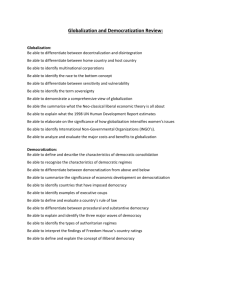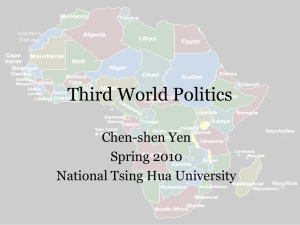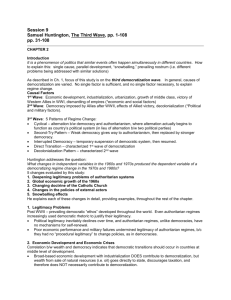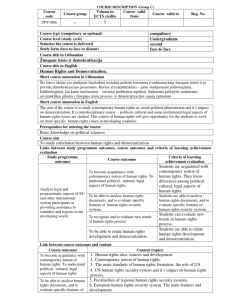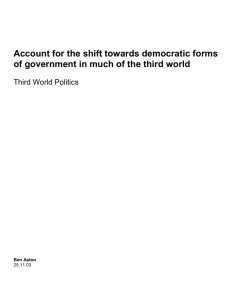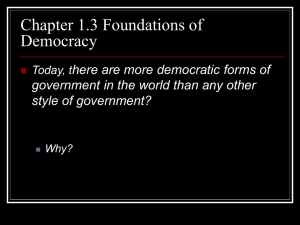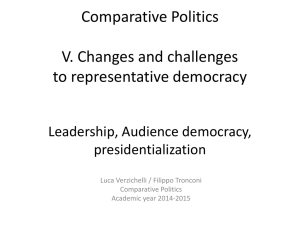DEMOCRATIZATION IN AFRICA:
advertisement
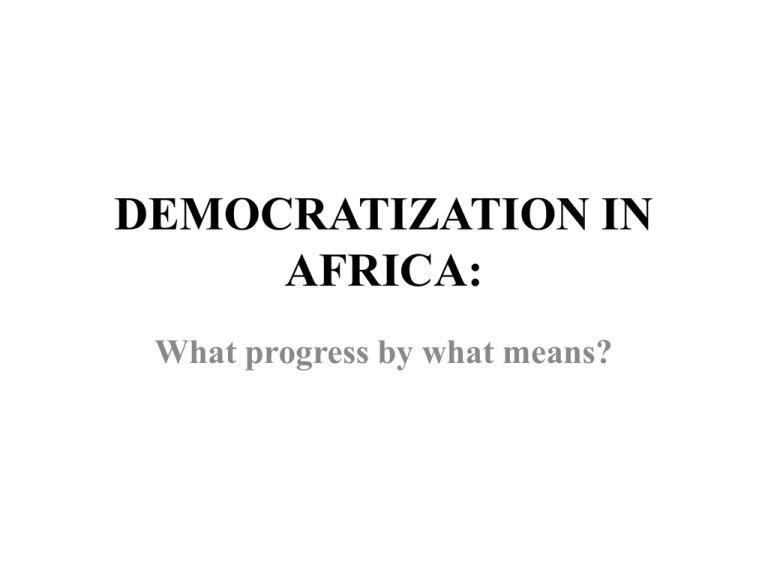
DEMOCRATIZATION IN AFRICA: What progress by what means? Outline of presentation: • • • • • • • The study of democratization Africa in comparative perspective Measuring democratization Key features of the African scene Where is progress taking place? How does it happen? Conclusions The study of democratization First phase: Second phase: Development leads to Democracy Regime transition Fifth phase? Third phase: Return to underlying causes Waves of democratizatio n Fourth phase: Hybrid regimes Measuring democratization (1) • Conceptual challenges: • Democracy/No democracy • Degrees of democracy • Sartori’s ladder of conceptualization • Collier & Levitsky’s “democracy with adjectives” • Data sources: • Multiple but most commonly used: • Freedom House Index • Polity IV • World Governance Indicators • “Barometers” Measuring democratization (2) • Challenges: • Biases in what is being measured • Differences in what is being measured • Collection of data where sampling is difficult • Survey data often superficial • Analysis to conform with mainstream concepts Africa in comparative perspective • Battle for independence did not translate into democracy, only on national sovereignty • Virtually no exposure to democracy on the continent prior to fall of Communism • Associational life rudimentary and often quelled by state • Ethnicity rather than class the backbone of social structure Sources on African democratization • Main sources: • Bratton and van de Walle: Democratic Experiments in Africa (1997) • Staffan Lindberg: Democracy and Elections in Africa (2006) • Articles in Journal of Democracy, Democratization, Journal of Modern African Studies, Comparative Political Studies Key features of the African scene • It has gotten generally better after tentative start, some backsliding in the 1990s and early 2000s, and a recovery after 2002. • Still significant differences among countries with just a couple of ”star performers” • The list of good ones is slowly growing longer but still a long list of weak or bad ones • Democratization takes time and involves learning from experience Top Ten Best and Worst Sources: Freedom House Index, World Governance Indicators The Best The Worst Botswana Angola Cape Verde Chad Ghana Congo Republic Lesotho Democratic Republic of Congo Mauritius Equatorial Guinea Namibia Guinea Sao Tomé & Principe Ivory Coast Senegal Somalia Seychelles Sudan South Africa Zimbabwe ”Free” Countries in Africa Source: Freedom House Index 1989 1995 2008 Botswana Benin Benin Gambia Botswana Botswana Mauritius Cape Verde Cape Verde Lesotho Ghana Malawi Lesotho Mali Mali Mauritius Mauritius Namibia Namibia Sao Tomé & Principe South Africa Sao Tomé & Principe South Africa Corruption perception index Source: Transparency International; N=180 countries; CPI: 10 high Country CPI 1998 CPI 2000 CPI 2004 CPI 2008 World ranking Botswana 6.1 6.0 6.0 5.8 36 Cape Verde -- -- -- 5.1 37 Mauritius 5.0 4.7 4.1 5.5 41 South Africa 5.2 5.0 4.6 4.9 54 Seychelles -- -- -- 4.8 55 Namibia 5.3 5.4 4.1 4.5 61 Ghana 3.3 3.5 3.6 3.9 67 Swaziland -- -- -- 3.6 72 Burkina Faso -- 3.0 3.2 3.5 80 Madagascar -- -- 3.1 3.4 85 Senegal 3.3 3.5 3.0 3.4 85 Mali -- -- -- 3.1 96 Benin -- -- -- 3.1 96 How does it happen? • Multiparty politics strengthens clientelism and by extension corrupt behavior • Supply of democracy still stronger than demand • Donors keep up pressure but it is weakening • Associational life is growing stronger in some countries (example: Kenya) • Rule of law and constitutionalism are getting more attention due to exposure of corruption Conclusions • Africa is still lagging behind Latin America and Central & Eastern Europe • Progress is being made but it is uneven and slow • Social structures with multiple horizontally structured ethnic groups not congenial • State remains soft and unable to lead move toward public integrity • Most regimes remain hybrid somewhere between democracy and dictatorship
